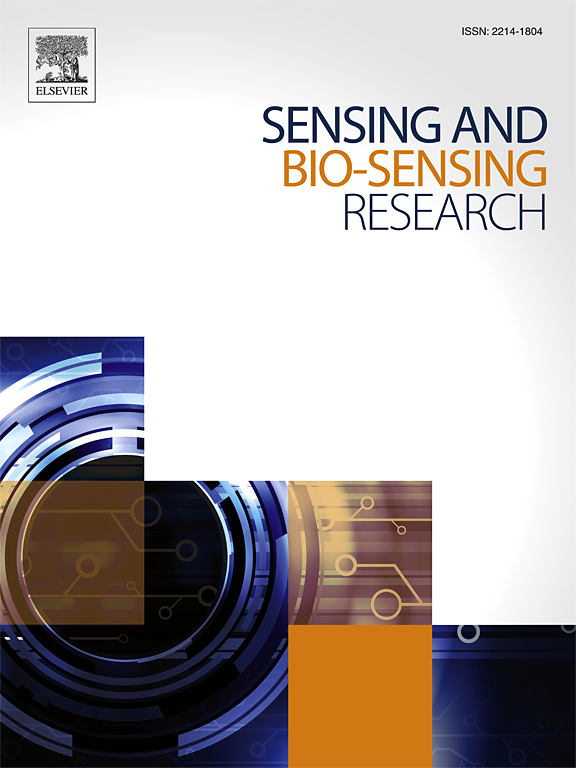Microneedle-based electrochemical sensors for real-time pH and sodium monitoring in physiological environments
IF 5.4
Q1 CHEMISTRY, ANALYTICAL
引用次数: 0
Abstract
This study proposes developing microneedle (MN) sensors for pH and sodium detection. MNs are minimally invasive, miniaturized needles capable of piercing the stratum corneum to access dermal interstitial fluid (ISF). They can offer accessible, quick, and precise point-of-care diagnostics, potentially replacing centralized laboratory testing. The study uses electrochemical techniques for sensor modification, detection, and in-vitro characterizations. This work aimed to create and validate a polymer-based disposable microneedle patch for future transdermal electrochemical sensing. Successful potentiometric sensor development for pH detection using SiOx as passivation layers with IrOx functionalization was demonstrated. Additionally, voltametric sodium sensors were achieved with ARcare passivation and PEDOT functionalization. Both pH and Na+ sensors exhibited linear responses within normal physiological levels across various solutions. The pH sensors showed sensitivity of −60.5 mV/pH and an accuracy of 97.7 % alongside an error margin of 2.3 %, while sodium sensors achieved a sensitivity of 3.29 nA/mM/mm2. Both sensors exhibit dynamic, rapid responses, along with good repeatability, stability, and selectivity. Over a twenty-one-day span for pH sensors and a fourteen-day period for sodium sensors, this study offers validation that microneedles serve as a viable foundation for wearable systems, enabling real-time, multiparameter biosensing of interstitial fluids.
基于微针的电化学传感器用于生理环境中pH和钠的实时监测
本研究提出开发用于pH和钠检测的微针(MN)传感器。MNs是一种微创的微型针头,能够穿透角质层进入真皮间质液(ISF)。它们可以提供方便、快速和精确的即时诊断,有可能取代集中的实验室检测。该研究使用电化学技术对传感器进行修改、检测和体外表征。这项工作旨在创建和验证一种基于聚合物的一次性微针贴片,用于未来的透皮电化学传感。成功的电位传感器开发pH检测使用SiOx作为钝化层与IrOx功能化证明。此外,通过ARcare钝化和PEDOT功能化实现了伏安式钠传感器。pH和Na+传感器在不同溶液的正常生理水平下均表现出线性响应。pH传感器的灵敏度为- 60.5 mV/pH,精度为97.7%,误差范围为2.3%,而钠传感器的灵敏度为3.29 nA/mM/mm2。这两种传感器都具有动态、快速的响应,以及良好的可重复性、稳定性和选择性。在为期21天的pH传感器和为期14天的钠传感器的研究中,该研究验证了微针作为可穿戴系统的可行基础,可以实现对组织间液的实时、多参数生物传感。
本文章由计算机程序翻译,如有差异,请以英文原文为准。
求助全文
约1分钟内获得全文
求助全文
来源期刊

Sensing and Bio-Sensing Research
Engineering-Electrical and Electronic Engineering
CiteScore
10.70
自引率
3.80%
发文量
68
审稿时长
87 days
期刊介绍:
Sensing and Bio-Sensing Research is an open access journal dedicated to the research, design, development, and application of bio-sensing and sensing technologies. The editors will accept research papers, reviews, field trials, and validation studies that are of significant relevance. These submissions should describe new concepts, enhance understanding of the field, or offer insights into the practical application, manufacturing, and commercialization of bio-sensing and sensing technologies.
The journal covers a wide range of topics, including sensing principles and mechanisms, new materials development for transducers and recognition components, fabrication technology, and various types of sensors such as optical, electrochemical, mass-sensitive, gas, biosensors, and more. It also includes environmental, process control, and biomedical applications, signal processing, chemometrics, optoelectronic, mechanical, thermal, and magnetic sensors, as well as interface electronics. Additionally, it covers sensor systems and applications, µTAS (Micro Total Analysis Systems), development of solid-state devices for transducing physical signals, and analytical devices incorporating biological materials.
 求助内容:
求助内容: 应助结果提醒方式:
应助结果提醒方式:


